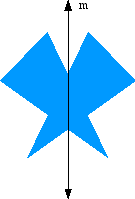|
 There are two types of symmetry: line symmetry, which involves reflection , and rotational symmetry, which involves rotation. There are two types of symmetry: line symmetry, which involves reflection , and rotational symmetry, which involves rotation.
Line Symmetry
A figure has a line of symmetry if it maps or folds onto itself under reflection in the line.
e.g. 
Line m is called the axis of symmetry.
Different shapes can have various numbers of axes of symmetry. e.g.
|
Name of shape
|
Diagram
|
Number of axes of symmetry
|
|
Rectangle
|
|
2
|
|
Hexagon
|
|
6
|
|
Scalene triangle
|
|
0
|
Rotational Symmetry
A figure has rotational symmetry if it maps onto itself as it is rotated about a point at its centre.
All figures have an order of rotational symmetry of at least 1.
The order of rotational symmetry is the number of times the shape maps onto itself during a rotation of 360°. e.g.
|
Name of shape
|
Diagram
|
Order of rotational symmetry
|
|
Rectangle
|
|
|
|
Hexagon
|
|
6
(60°, 120°, 180°, 240°, 300°and 360°)
|
|
Scalene triangle
|
|
1
|
Total Order of Symmetry
The total order of symmetry = number of axes of symmetry + order of rotational symmetry.
The table shows the symmetry properties of some common shapes.
| Shape |
Axes of symmetry |
Order of rotational symmetry |
Total order of symmetry |
|
Scalene triangle
|
0 |
1 |
1 |
|
Isosceles triangle
|
1 |
1 |
2 |
|
Equilateral triangle
|
3 |
3 |
6 |
|
Kite
|
1 |
1 |
2 |
|
Trapezium
|
0 |
1 |
1 |
|
Isosceles trapezium
|
1 |
1 |
2 |
|
Parallelogram
|
0 |
2 |
2 |
|
Rhombus
|
2 |
2 |
4 |
|
Rectangle
|
2 |
2 |
4 |
|
Square
|
4 |
4 |
8 |
|
Regular pentagon
|
5 |
5 |
10 |
|
Regular hexagon
|
6 |
6 |
12 |
|
Regular octagon
|
8 |
8 |
16 |
A figure has point symmetry if it maps onto itself under a rotation of 180° (a half turn). e.g. A parallelogram.
|